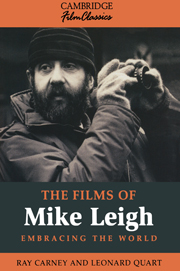Book contents
- Frontmatter
- Contents
- Editorial Note
- Acknowledgments
- Biographical and Cultural Introduction
- 1 Stylistic Introduction: Living beyond Consciousness
- 2 Fictitious Selves: Bleak Moments
- 3 Personal Freezing and Stylistic Melting: Hard Labour
- 4 Existence without Essences: The Kiss of Death
- 5 Defeating Systems of Knowing: Nuts in May
- 6 Losing Track of Who You Are: Abigail's Party
- 7 We Are the Hollow Men: Who's Who
- 8 Inhabiting Otherness: Grown-Ups
- 9 Manufactured Emotions: Home Sweet Home
- 10 Challenging Easy Understandings: Meantime
- 11 Holding Experience Loosely: High Hopes
- 12 Circulation Is the Law of Life: Life Is Sweet
- 13 Desperate Lives: Naked
- Epilogue: The Feel of Life
- Notes
- Filmography
- Bibliography
- Index
4 - Existence without Essences: The Kiss of Death
Published online by Cambridge University Press: 05 June 2012
- Frontmatter
- Contents
- Editorial Note
- Acknowledgments
- Biographical and Cultural Introduction
- 1 Stylistic Introduction: Living beyond Consciousness
- 2 Fictitious Selves: Bleak Moments
- 3 Personal Freezing and Stylistic Melting: Hard Labour
- 4 Existence without Essences: The Kiss of Death
- 5 Defeating Systems of Knowing: Nuts in May
- 6 Losing Track of Who You Are: Abigail's Party
- 7 We Are the Hollow Men: Who's Who
- 8 Inhabiting Otherness: Grown-Ups
- 9 Manufactured Emotions: Home Sweet Home
- 10 Challenging Easy Understandings: Meantime
- 11 Holding Experience Loosely: High Hopes
- 12 Circulation Is the Law of Life: Life Is Sweet
- 13 Desperate Lives: Naked
- Epilogue: The Feel of Life
- Notes
- Filmography
- Bibliography
- Index
Summary
I don't put in all kinds of semaphores to make sure that unintelligent members of the audience get it. I just put it in there like it is.
–Mike LeighIt is sometimes said of a painting that it is two paintings: the one you see at a distance and the one you see up close. In a similar vein, there are at least two different experiences in each of Mike Leigh's movies: the one you have while the film is running and the one you have thinking back on it later. The difference is that a viewer of a painting generally takes in the big picture first and moves in to study the details later, while in a Leigh movie the close-up view – the rough, unassimilated, raw experience you have while you are watching it – may be the only thing visible for a long time. The big picture may not emerge for a while, if ever.
Hollywood attempts to minimize the difference between the two views. In an effort to keep the viewer continuously informed about the big picture, details are continuously linked to a larger pattern of significance. A problem-solving or goal-oriented narrative is one way of doing that. A viewer knows what to pay attention to, and what it means, by referring it to the general goal being pursued. If something assists the characters in solving their problems or answering their questions, it matters; if it doesn't, it doesn't.
- Type
- Chapter
- Information
- The Films of Mike Leigh , pp. 65 - 79Publisher: Cambridge University PressPrint publication year: 2000



